ι2 Scorpii, Latinised as Iota2 Scorpii, is a single star in tail of the zodiac constellation of Scorpius. It has an apparent visual magnitude of +4.82, and is visible to the naked eye. Because of parallax measurement errors, the distance to this star is only approximately known: it lies around 2,500 light years away from the Sun. It has a visual companion, a magnitude 11.0 star at an angular separation of 31.60 arcseconds along a position angle of 36°, as of 2000.

27 Canis Majoris is a binary star system in the northern constellation of Canis Major, located approximately 1,700 light years away from the Sun. It has the variable star designation EW Canis Majoris; 27 Canis Majoris is the Flamsteed designation. This system is visible to the naked eye as a dim, blue-white hued star with an apparent visual magnitude of +4.65. It is moving away from the Earth with a heliocentric radial velocity of 16 km/s.
42 Camelopardalis is a single star in the constellation Camelopardalis, located roughly 770 light years away from the Sun. It is visible to the naked eye as a faint, blue-white hued star with an apparent visual magnitude of 5.14. The visual magnitude of the star is diminished by an extinction of 0.22 due to interstellar dust. It is moving further from the Earth with a heliocentric radial velocity of 3 km/s. 42 Camelopardalis has a peculiar velocity of 24.4+1.9
−2.1 km/s and may be a runaway star.

Chi Carinae, Latinised from χ Carinae, is a star in the southern constellation of Carina. It is a third-magnitude star and is one of the brighter members of the constellation. The distance to the star can be determined directly through parallax measurements, yielding an estimate of roughly 450 light-years with a 6.7% margin of error. This star is a suspected astrometric binary, although nothing is known about the companion.
HD 79447 is a single star in the southern constellation of Carina. It has the Bayer designation i Carinae, while HD 79447 is the identifier from the Henry Draper catalogue. This star has a blue-white hue and is visible to the naked eye with an apparent visual magnitude of +3.96. It is located at a distance of approximately 540 light years from the Sun based on parallax, and has an absolute magnitude of −2.14. The star drifting further away with a radial velocity of +18 km/s. It is a candidate member of the Lower Centaurus–Crux group of the Sco OB2 association.
N Carinae is a single star in the constellation Carina, just to the northeast of the prominent star Canopus. This object has a white hue and is faintly visible to the naked eye with an apparent visual magnitude of 4.35. Based on parallax, it is located at a distance of approximately 1,360 light years from the Sun. It has an absolute magnitude of −3.75, and is drifting further away with a radial velocity of +22.5 km/s.
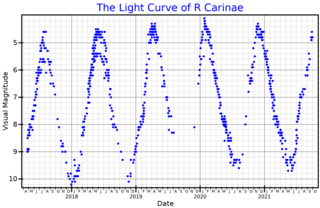
R Carinae is a double star in the southern constellation of Carina. The brighter component is a variable star that can be viewed with the naked eye at peak brightness, but is usually too faint to be seen without a telescope, having an apparent visual magnitude that fluctuates around 7.43. This star is located at a distance of approximately 1,300 light years from the Sun based on parallax, and is drifting further away with a radial velocity of +28 km/s.

V344 Carinae is a single star in the southern constellation of Carina. It has the Bayer designation f Carinae, while V344 Carinae is its variable star designation. This star has a blue-white hue and is visible to the naked eye with an apparent visual magnitude that fluctuates around 4.50. Historically, it was mentioned in the Almagest, suggesting that some time around 130 BCE it was brighter than its current magnitude. This object is located at a distance of approximately 610 light-years from the Sun based on parallax. The star is drifting further away with a radial velocity of around +27 km/s.
HD 83944 is a star system in the constellation Carina. This has the Bayer designation m Carinae, while HD 83944 is the identifier from the Henry Draper catalogue. It is a suspected variable with an apparent visual magnitude that fluctuates around 4.51 with an amplitude of 0.5. The system is located at a distance of approximately 226 light years from the Sun based on parallax, and it has an absolute magnitude of 0.31. It is a member of the Carina association of co-moving stars.

V520 Carinae is a single star in the southern constellation of Carina. It has the Bayer designation w Carinae, while V520 Carinae is a variable star designation. The star has an orange hue and is faintly visible to the naked eye with an apparent visual magnitude that fluctuates around +4.58. It is located at a distance of approximately 1,140 light years from the Sun based on parallax, and it is drifting further away with a radial velocity of +9 km/s. It is a candidate member of the IC 2391 moving group of co-moving stars.
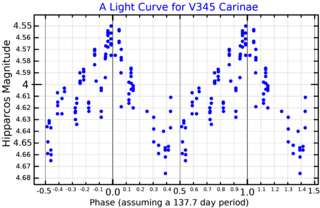
V345 Carinae is a star in the constellation Carina. It has the Bayer designation E Carinae; V345 Carinae is the variable star designation. The star has a blue-white hue and is faintly visible to the naked eye with an apparent visual magnitude that fluctuates around +4.66. Its actual brightness varies from magnitude +4.67 to +4.78 with a period of 137.7 days. Based on parallax measurements, it is located at a distance of approximately 1,010 light years from the Sun. It is drifting further away with a radial velocity of around +19 km/s.

V376 Carinae is a binary star system in the southern constellation of Carina. It has the Bayer designation b1 Carinae; V376 Carinae is the variable star designation. The system is visible to the naked eye as a faint point of light with a combined apparent magnitude of +4.69. The distance to this system from the Sun is approximately 650 light years based on parallax. It is drifting further away with a radial velocity of +27 km/s.
Pi2 Cygni, Latinized from π2 Cygni, is a triple star system in the northern constellation of Cygnus. It is visible to the naked eye about 2.5° east-northeast of the open cluster M39, having an apparent visual magnitude of 4.24. Based upon an annual parallax shift of 2.95 mas, it is located at a distance of roughly 1,100 light years from the Sun.
2 Vulpeculae is a binary star system in the northern constellation of Vulpecula, located around 1,800 light years away from the Sun. It is visible to the naked eye as a faint, blue-white hued star with an apparent visual magnitude of 5.43.

Epsilon Pyxidis (ε Pyxidis) is quadruple star system in the southern constellation of Pyxis. It is faintly visible to the naked eye, having a combined apparent visual magnitude of +5.60. Based upon an annual parallax shift of 15.39 mas as seen from Earth, it is located around 212 light years from the Sun. The system is deemed to be a member of the Sirius supercluster of stars that share a common motion through space.
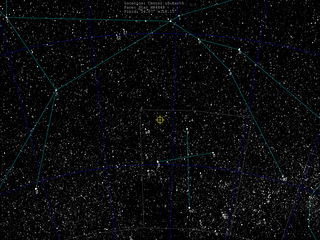
HD 110956 is a single star in the southern constellation of Crux. It is faintly visible to the naked eye with an apparent visual magnitude of 4.62. The distance to this star is approximately 385 light years based on parallax and it is drifting further away with a radial velocity of 15.5 km/s. It is a probable member of the Lower Centaurus–Crux subgroup of the Scorpius–Centaurus association.
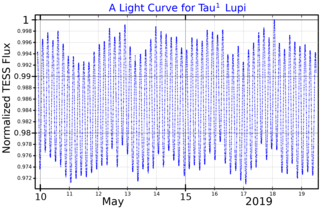
Tau1 Lupi, Latinized from τ1 Lupi, is a solitary star in the southern constellation of Lupus. It is visible to the naked eye with an apparent visual magnitude of 4.5. Based upon an annual parallax shift of only 2.99 mas as seen from Earth, it is located about 1,090 light years from the Sun. Tau1 Lupi may be a runaway star having a peculiar velocity of 32.6±3.6 km/s. It is a member of the Upper Centaurus–Lupus sub-group of the nearby Sco OB2 association.

Upsilon Lupi, Latinized from υ Lupi, is a star system in the southern constellation of Lupus. It is faintly visible to the naked eye with an apparent visual magnitude of 5.37. Based upon an annual parallax shift of 8.02 mas as seen from Earth, it is located around 410 light years from the Sun. The two components of Upsilon Lupi share a common proper motion through space and most likely form a wide binary star system. As of 1945, the pair had an angular separation of 1.50 arc seconds along a position angle of 40°.
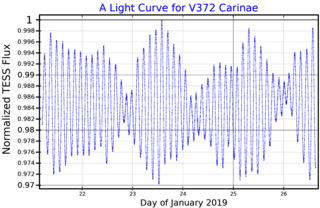
V372 Carinae is a single star in the southern constellation of Carina. Located around 1300 light-years distant. It shines with a luminosity approximately 1742 times that of the Sun and has a surface temperature of 14132 K. It is a Beta Cephei variable.

FN Canis Majoris is a binary star system in the southern constellation Canis Major, near the northern constellation border with Monoceros. It is dimly visible to the naked eye with a combined apparent visual magnitude of 5.41. The system is located at a distance of approximately 3,000 light years from the Sun based on parallax, and is drifting further away with a radial velocity of +31 km/s. It is a runaway star associated with the Sh 2-296 nebula in the CMa OB1 association, and has a conspicuous bow-shock feature.













